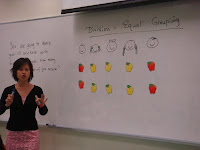


It is promising that I see at least one very good lesson in every microteaching session. teaching is a complex activity that defies description in words. one has to see it being played out before one's eyes. I hope the trainee teachers in my group who are observers are capable of seeing good examples of instruction. This is why I assign them the roles of 'students' and 'observers'. On the days they are the 'observers' they can divert all their attention to witness the complex activity of teaching without being distracted.
In Rendra's ;esson, we saw the use of PowerPoint to model the subtraction process. I wished he had stuck to this. Unfortunately, he moved to doing the subtraction in abstract symbols too soon. In Naz lesson, which was brilliant, I saw him being able to handle the complexities of being a teacher bringing a lesson plan to life. In particular, the pictorial-abstract linkage was well done. He used the 'models' to explain the symbolic manipulation. The subtraction process can be made obvious using suitable straegies that trainee teachers should be able figure out. In Hafeez' lesson, the idea of regrouing was not modelled by the pictorial representation. The use of a strory was good. especially if the teacher can act the situations out by making voices for Mr Gopan and whoever else in the story. Also, the pizza was impressive,













